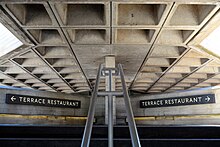
A waffle slab or two-way joist slab is a concrete slab made of reinforced concrete with concrete ribs running in two directions on its underside. The name waffle comes from the grid pattern created by the reinforcing ribs. Waffle slabs are preferred for spans greater than 40 feet (12 m), because, for a given mass of concrete, they are much stronger than flat slabs, flat slabs with drop panels, two-way slabs, one-way slabs, and one-way joist slabs.

Description
A waffle slab is flat on top, while joists create a grid like surface on the bottom. The grid is formed by the removal of molds after the concrete sets. This structure was designed to be more solid when used on longer spans and with heavier loads. This type of structure, because of its rigidity, is recommended for buildings that require minimal vibration, like laboratories and manufacturing facilities. It is also used in buildings that require big open spaces, like theatres or train stations. Waffle slabs are composed by intricate formwork, and may be more expensive than other types of slabs, but depending on the project and the quantity of concrete needed it may be cheaper to build.
There are two types of waffle slab system:
- One way waffle slab system
- Two way waffle slab system
Construction process
A waffle slab can be made in different ways but generic forms are needed to give the waffle shape to the slab. The formwork is made up of many elements: waffle pods, horizontal supports, vertical supports, cube junctions, hole plates, clits and steel bars. First the supports are built, then the pods are arranged in place, and finally the concrete is poured.
This process may occur in three different approaches, however the basic method is the same in each:
- In situ: Formwork construction and pouring of concrete occur on site, then the slab is assembled (if required).
- Precast: The slabs are made somewhere else and then brought to the site and assembled.
- Pre-fabricated: The reinforcements are integrated into the slab while being manufactured, without needing to reinforce the assembly on site. This is the most expensive option.
Waffle slab design
Different guides have been made for architects and engineers to determine various parameters of waffle slabs, primarily the overall thickness and rib dimensions. The following are rules of thumb, which are explained further in the accompanying diagrams:

- Slab depth is typically 75 mm (3 in) to 130 mm (5 in) thick. As a rule of thumb, the depth should be 1⁄24 of the span.
- The width of the ribs is typically 130 mm (5 in) to 150 mm (6 in), and ribs usually have steel rod reinforcements.
- The distance between ribs is typically 915 mm (3 ft).
- The height of the ribs and beams should be 1⁄25 of the span between columns.
- The width of the solid area around the column should be 1⁄8 of the span between columns. Its height should be the same as the ribs.

Diagram showing waffle slab rib and Beam Heights rule of thumb formulas.

Advantages
The waffle slab floor system has several advantages:
- Better for buildings that require less vibrations – this is managed by the two way joist reinforcements that form the grid.
- Bigger spans can be achieved with less material, being more economical and environmentally friendly
- Some people find the waffle pattern aesthetically pleasing
- Greater load capacity than traditional one-way slabs
- Forms can be implemented with wood, concrete or steel
- If holes are provided between the ribs, building services can be run through them. One proprietary implementation of this system is called Holedeck.
Disadvantages
- Greater quantities of formwork materials are needed, which can be very costly
- Waffle slabs are thicker than flat slabs, so the height between each floor must be greater to have enough space for the slab system and other building services
- Waffle slabs are preferred for flat topographical areas not sloped sites
Examples
- Royal National Theatre, London, United Kingdom
- Washington Metro Building
- Logistic and Telecommunication SL, Madrid, Spain
- Barangaroo House, Sydney, Australia
- GS1 Portugal, Lisboa, Portugal
- Galbraith Hall, UC San Diego, California
- odD House, Quito, Ecuador
- Centro de Bellas Artes de Caguas Parking Garage, Caguas, Puerto Rico
See also
References
- Harris, Cyril (2005). Dictionary of Architecture and Construction. McGraw Hill. p. 1051. ISBN 0-07-145237-0.
- ^ "Waffle Slab". Civil Engineers Forum. 2014-12-25. Retrieved 2018-12-05.
- ^ Allen, Edward; Iano, Joseph (2017). The Architect's Studio Companion (Sixth ed.). New Jersey: Wiley. p. 124. ISBN 9781119092414.
- ^ Anupoju, Sadanandam (2017-12-13). "Waffle Slab - Construction Procedure, Characteristics and Advantages". The Constructor. Retrieved 2018-11-18.
- ^ Ching, Francis D.K. (2014). Building Construction Illustrated (Fifth ed.). New Jersey: Wiley. p. 4.06. ISBN 978-1-118-45834-1.
- "HOLEDECK | certificate system lightened reinforced concrete slabs which saves 20% in construction". Archived from the original on 2019-03-28. Retrieved 2018-12-05.
- "Logytel I+D / Alarcón + Asociados". ArchDaily. 2014-01-02. Retrieved 2018-12-04.
- "Barangaroo House / Collins and Turner". ArchDaily. 2018-08-08. Retrieved 2018-12-04.
- "GS1 Portugal / PROMONTORIO". ArchDaily. 2017-05-17. Retrieved 2018-12-04.
- "UC San Diego - Galbraith Hall Interior Renovation / Kevin deFreitas Architects". ArchDaily. 2017-02-03. Retrieved 2018-12-04.
- "odD House 1.0 / odD+". ArchDaily. 2015-04-16. Retrieved 2018-12-04.
| Concrete | |
|---|---|
| History | |
| Composition | |
| Production | |
| Construction | |
| Science | |
| Types | |
| Applications | |
| Organizations | |
| Standards | |
| See also | |